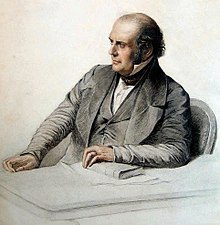Guglielmo Libri Carucci dalla Sommaja
| Guglielmo Libri Carucci dalla Sommaja | |
|---|---|
 |
|
| Born | January 1, 1803 Florence, Italy |
| Died | September 28, 1869 (aged 66) Fiesole, Italy |
| Nationality | Italian |
| Education | Degree in mathematics (1820) |
| Alma mater | University of Pisa |
| Occupation | Professor of mathematics |
| Known for | Book and manuscript theft |
Guglielmo Libri Carucci dalla Sommaja (January 1, 1803 – September 28, 1869) was an Italian count and mathematician, who became known for his love and subsequent theft of ancient and precious manuscripts.
Appointed the Inspector of Libraries in France, Libri began stealing the books he was responsible for, fleeing to England when the theft was discovered, along with 30,000 books and manuscripts inside 18 trunks. He was sentenced in France to 10 years in jail in absentia; some of the stolen works were returned when he died, but many remained missing.
In June 2010, one of the documents he stole—a letter from the French philosopher René Descartes, dated May 27, 1641—was handed back to France after being found in a library in Haverford College, in Pennsylvania. The letter had been donated by the widow of a college alumnus in 1902, and was discovered only after a philosopher from Utrecht University in the Netherlands read about it on the Internet, and contacted the college to tell them what they had in their library; the existence of the letter had been known to philosophers, but not its contents. The letter was written by Descartes to Father Marin Mersenne who had been overseeing the publication of Descartes's Meditations on First Philosophy.
He was born on born on New Years Day, January 1, 1803 in Florence, Italy. He entered the University of Pisa in 1816, starting to study law, but soon switching to mathematics. He graduated in 1820, his first works being praised by Babbage, Cauchy, and Gauss.
In 1823, at the age of 20, he was appointed Professor of Mathematical Physics at Pisa, but did not relish teaching and the following year went on sabbatical leave, traveling to Paris. There, he became friends with many of the most prominent French mathematicians of the day, including Laplace, Poisson, Ampère, Fourier and Arago. Upon his return to Italy, he became involved in politics, conspiring with the secret society of the Carbonari to advocate a liberal constitution in the Grand Duchy of Tuscany. Faced with arrest and prosecution, he fled to France
...
Wikipedia
